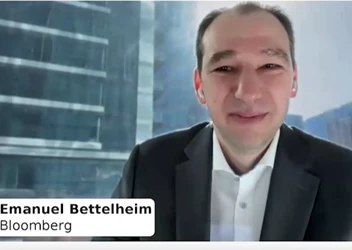The keys to unlock the potential of generative AI
The CEO of Writer, May Habib, on how generative AI helps amplify human intelligence
Add bookmark
We respect your privacy, by clicking "Download Your Copy" you agree to having your details passed onto the sponsor who may promote similar products and services related to your area of interest subject to their privacy policy. You have the right to object. In addition, you will receive our e-newsletter, including information on related online learning opportunities. For further information on how we process and monitor your personal data, and information about your privacy and opt-out rights, click here. Download PDF Attachment
Please click the link above to download the interview
When someone utters the phrase ‘generative AI’, you’ll often hear the word ‘potential’ used in the same breath. For example, it’s often said that generative AI is a potential game-changer for business. However, there are two sides to the coin here.
From one perspective, the use of the word ‘potential’ conjures a world of possibilities. But it also signals that transformation won’t occur automatically – potential needs to be unlocked.
So accessing the treasure trove of opportunity within the realm of generative AI is possible for any business – as long as it has the right set of keys.
Fortunately, there are innovators in the field who have made it their mission to supply enterprises with tools designed to unleash the power of generative AI and extract its full value in the relevant business context.
One of them is May Habib, CEO of Writer – the lead partner for the Generative AI Summit taking place on May 16-17, 2023 at Hilton Syon Park, London.
Writer is a generative AI platform that uses machine learning and natural language processing to empower enterprises and their people — from marketing and support through to product and HR – through content creation.
Illustrating the platform’s scope, Habib explains that the platform is often used by clients to refine their content to exacting specifications.
“We have customers who have trained a widget to rewrite content in their CEO’s brand voice,” she says. “Lots of tech companies are very particular, and not just tech companies – we’ve got a telco that has done this also.”
According to Habib, this kind of use harnesses the automation power of AI – “not to replace people but to do the things that everybody is scratching their heads over, wondering how the heck they can do it”.
Another use case is from a very large healthcare company in the US. “There’s a whole team dedicated to reading the news – literally scouring the news – and they create these very in-depth briefs on everything from new research to new regulation,” Habib explains. “And we can take that whole breadth of information that’s gathered by these experts and help them create newsletters and emails and content for social media.”
Habib observes that intelligence is most valuable when it goes beyond the training data – outside the realm of the probable.
“That’s what I think makes Writer so different from other solutions,” she says. “We’re not creating a generic answer or piece of content that barely passes the grade to replace what an enterprise’s people are doing. Rather, we’ll go in and show them how they can amplify what their people are already doing to reach more audiences, get into more channels or cut down on a content backlog.”
Writer’s raison d’etre is “amplifying the alpha”, says Habib. The solution is based around “repurposing and transformation use cases rather than net new knowledge – because the vast majority of people that we work with have the net new knowledge part down”.
According to the CEO, finding Writer’s most productive fit within an enterprise is about focusing on the organisation. “We start with the deliverables and the workflows, not the technology,” Habib explains.
“So when we’re meeting with marketing and it’s a team that leans towards SEO, we’re talking about SEO goals. If it’s a team that deals with events, we’re talking about event marketing and all the different types of writing we do. If we’re talking to the content strategy team within recruiting, we’re talking about email sequences and how to use thought leadership to excite the highest level candidates, and how you adjust an email according to where somebody is in the stage of the funnel.”
This approach is summarised by Habib as “their context, backward”.
She insists: “This is better than saying, ‘Hey, here’s the shiny foundation model and it’s ours,’ and, ‘Our training data is better than their training data,’ because nobody cares! A lot of companies are forgetting sales 101 and going back to ‘here’s the fancy new thing we built’, and I don’t think that’s actually working.”
What’s more, Habib believes that inserting AI into an enterprise by “starting with the technology versus what people are doing” can create a climate of fear, which in turn forms an unnecessary barrier to AI adoption. An onus on education can also help to ease anxieties within the workforce.
“The majority of people want to learn new stuff,” Habib observes. “They want to be better at their craft. But what they’re not excited about is thinking some dinky thing is going to replace their craft. So we make sure we’re helping companies educate their people on what AI really is.”
This education involves training teams on how their data, their context and their workflows can improve outputs, and how those outputs can be of service in helping people to cut down on repetitive and manual tasks. “Then they can focus on the alpha – on the creative inquiry part of their jobs,” Habib explains.
The CEO admits that generative AI comes with some fairly hefty ethical considerations, but as with the technology’s practical application, context is all important.
“Are we all going to be OK with 20 million fewer knowledge jobs, which is one of the estimates?” she asks. “Well, yes, if what we’re saying is 20 million knowledge jobs with a twist are what replaces them, and people are actually in their seats doing slightly different things.”
According to Habib, one of her company’s roles is helping enterprise executives increase the level of AI literacy within their companies – “because that’s going to move us along the curve, the table stakes of AI adoption”.
But in terms of growth, the CEO also observes that generative AI is “spreading inside of companies pretty dramatically right now”.
We can expect the trend to continue. “Once folks really get their hands on what true AI looks like, it’s really hard to tear it from their hands,” she concludes.

































